

GREEN JUNE BEETLES and SCOLIA WASPS cruising over lawns and feeding on fruits and vegetables;
FALL WEBWORMS on a variety of trees;
SOYBEAN APHIDS on soybean;
MILLIPEDES invading homes in some areas;
WALNUT CATERPILLARS, ORANGE STRIPED OAK WORMS beginning to feed.


 The status of blue mold in the U.S. hasn't changed from last week. Thus far, the disease has been reported in GA, FL, and VA only. Blue mold poses a minimal threat to KY for now. Current forecasts indicate that inoculum from known sources of blue mold should not move into our area; rather, the trajectories are predicted to affect states along the Eastern Seaboard. We do have active sources in the Deep South, so continued monitoring our crops in the field for signs and symptoms of blue mold is the best advice. The weather for the week of July 7 will be warm in general with moderate chances of rain. Conditions during the week should be unfavorable for development of blue mold should inoculum be introduced into the region.
The status of blue mold in the U.S. hasn't changed from last week. Thus far, the disease has been reported in GA, FL, and VA only. Blue mold poses a minimal threat to KY for now. Current forecasts indicate that inoculum from known sources of blue mold should not move into our area; rather, the trajectories are predicted to affect states along the Eastern Seaboard. We do have active sources in the Deep South, so continued monitoring our crops in the field for signs and symptoms of blue mold is the best advice. The weather for the week of July 7 will be warm in general with moderate chances of rain. Conditions during the week should be unfavorable for development of blue mold should inoculum be introduced into the region.
For the latest blue mold status and other tobacco disease information, check the KY Blue Mold Warning System online.
![]() http://www.uky.edu/Agriculture/kpn/kyblue/kyblue.htm
http://www.uky.edu/Agriculture/kpn/kyblue/kyblue.htm

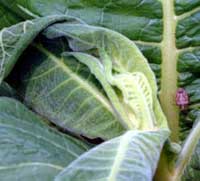 The sudden collapse of a single upper leaf or even the entire bud area of a tobacco plant can be the result of a stink bug feeding caused when these insects their sucking mouthparts into a leaf midrib or the upper stalk. The tissue around the bite site collapses then turns dark green. Under cool, cloudy conditions, the leaf will re-expand and be relatively normal. However, under very hot, sunny conditions, the affected leaf will scald, turning yellow, then brown to black. Feeding near the top of the stalk causes a general collapse of the bud area and may kill it.
The sudden collapse of a single upper leaf or even the entire bud area of a tobacco plant can be the result of a stink bug feeding caused when these insects their sucking mouthparts into a leaf midrib or the upper stalk. The tissue around the bite site collapses then turns dark green. Under cool, cloudy conditions, the leaf will re-expand and be relatively normal. However, under very hot, sunny conditions, the affected leaf will scald, turning yellow, then brown to black. Feeding near the top of the stalk causes a general collapse of the bud area and may kill it.
The brown stink bug (to right of leaf midrib) is usually the cause of most of this injury. A single adult may feed on several plants as it moves over a field. The damage is often greatest near field edges. Also, the plant reaction is localized so tissue damage is often limited to a distinct part of the plant. Stink bugs do not seem to remain in tobacco fields very long and usually are long gone by the time the time symptoms are noticed. An insecticide application should be aimed at preventing additional damage if there is significant feeding - 10% to 20% of the plants - and the insects are still present in the field. In that case, an application of Orthene or Warrior may be helpful.
The stalk borer caterpillar can cause yellowing and wilt that can affect individual leaves or the entire plant. Usually, wilting occurs on randomly scattered plants along field edges or grassy waterways. Wilting or yellowing results from the disruption of water and nutrient movement that occurs when a caterpillar tunnels into a leaf midrib or the main stalk. An entry hole often can be found and the distinctive larva is within the tunnel. Small larvae are cream colored with a dark brown or purple band around the body near the front end. Several light stripes run the length of the body. Full grown larvae may lack the dark stripes and band, making them harder to identify. Stalk borers move from grasses that have become too small to contain them into the first plant they find as they crawl along the ground. Stalk borers occur in the plant where they are protected from an insecticide application. Fortunately, few plants and infested and the borers do not tend to leave a plant once they have entered it.
 For more information about tobacco pests, visit
"Insect Management Recommendations".
For more information about tobacco pests, visit
"Insect Management Recommendations".

 This year there is great interest in applying fungicides to both corn and soybean in Kentucky, and elsewhere. Interest is being fueled by high crop prices, aggressive marketing of fungicides by manufacturers, and the perception by producers that applying fungicides will result in a net economic benefit (increased yield and perhaps quality). We anticipate that 30-50% of Kentucky's corn and soybean acres (800,000 to 1 million acres) will be sprayed with a fungicide during 2008. Nationally, the number of acres treated could approach 50 million (for reference, there are about 160 million acres of corn and soybean in the U.S.). These numbers represent a radical departure from business-as-usual corn and soybean production!
This year there is great interest in applying fungicides to both corn and soybean in Kentucky, and elsewhere. Interest is being fueled by high crop prices, aggressive marketing of fungicides by manufacturers, and the perception by producers that applying fungicides will result in a net economic benefit (increased yield and perhaps quality). We anticipate that 30-50% of Kentucky's corn and soybean acres (800,000 to 1 million acres) will be sprayed with a fungicide during 2008. Nationally, the number of acres treated could approach 50 million (for reference, there are about 160 million acres of corn and soybean in the U.S.). These numbers represent a radical departure from business-as-usual corn and soybean production!
What claims are being made about fungicides?
Fungicides (primarily strobilurin-based products - Table 1) are being marketed for control of certain fungal diseases. However, maintaining optimal health of treated crops has been the main marketing strategy of fungicide manufacturers. In addition to disease control benefits, fungicide manufacturers have promoted fungicides for optimizing physiological and biochemical processes in crops. As a result, treated crops are reportedly better able to withstand crop stresses, and yield more, compared with non-treated crops.
Table 1. Fungicides commonly being used in corn and soybean production throughout the U.S.
| Fungicide | Active ingredient(s) | Chemical class(es) |
|---|---|---|
| Headline | Pyraclostrobin | Strobilurin |
| Quadris | Azoxystrobin | Strobilurin |
| Quilt | Azoxystrobin + propiconazole | Strobilurin + triazole |
| Stratego | Trifloxystrobin + propiconazole | Strobilurin + triazole |
"Greening" effect
We have seen some of these data on how strobilurin fungicides, in particular, are reported to impact plant physiology/biochemistry of crops. Some of it looks very convincing, and there is no denying that treated crops often (but not always) show what has been called a "greening effect". Most producers consider this greening effect to be a good thing that necessarily translates into higher yields compared to non-treated crops. However, this is definitely not the case and we have seen numerous situations in research plots and grower fields where yields of corn or soybean were not improved by fungicide treatment, even when the greening effect was evident.
As a side note, the greening effect can be a negative thing as well. It can slow or even delay harvest, and grain (mainly corn) may require drying if harvested at a higher moisture content compared to non-treated crops.
Response to fungicides for crops under severe stress or low stress/low disease conditions
We are plant pathologists and not crop physiologists. Consequently, we focus primarily on the disease control aspects of fungicide treatments. However, we have noted that applying fungicides to corn or soybean, in replicated trials, frequently does not produce statistically higher yields when tests are grown under serious stress conditions, such as drought, or under low stress/low disease situations. For example, we have conducted 28 replicated soybean fungicide tests in Kentucky since 2003. Disease pressure and crop stress were minimal in most of these tests; a few experienced severe drought stress. In these tests, statistically significant yield increases (in at least one fungicide treatment) were seen in seven of 28 tests (25%). These findings are consistent with those of researchers at other land grant universities who have conducted several hundred soybean fungicide tests since 2002, most of which had very little disease development. Arvydas Grybauskas (Univ. of Maryland) summarized the results of 74 replicated tests, conducted across 15 northern states in 2006. Yields in fungicide-treated plots ranged from -6 bu/A to +18 bu/A (mean +2.8 bu/A). Some of the yield differences in individual studies were statistically significant; others were not. The main point is that soybean yields, on average, are somewhat higher when treated with a fungicide (mostly a single application of a strobilurin fungicide at early pod formation), but the yield results from individual treatments and tests vary wildly. To be fair, we note that results summarized by industry suggest a more favorable outcome.
How often do fungicides improve corn yield?
Since applying fungicides to field corn is a relatively new production practice (only since 2006), most of the research on corn is very recent. However, research thus far should temper enthusiasm for the routine use of fungicides in corn. For example, last year Chad Lee and Paul Vincelli conducted three corn fungicide tests under low disease, good growing conditions. In these tests, fungicide application did not produce a significant yield difference. The same is true for four UK trials with strobilurin fungicides conducted in western Kentucky several years ago. Similarly, in replicated tests conducted throughout the Midwest and beyond during 2007, research shows that it is far from guaranteed that a fungicide application will provide an economic yield boost (Table 2). Although the average yield response across all treatments (Headline, Quilt, or Stratego at tasseling) tested was +3.5 bu/acre, 46 of 168 data points (27%) showed yield loss when a fungicide was applied. The range of response of individual crops to a fungicide ranged from a 27 bu/A yield increase to a 29 bu/A yield loss. That's right, a 29 bu/A yield loss, with fungicides applied according to label directions. Some of these cases of yield loss are due to damage to the developing ear. This damage has been called "arrested ear development", whereby the ears are moderately or highly stunted, with reduced numbers of kernels per row. (It should be noted that arrested ear development can be caused by factors other than fungicide, though pre-tassel application of strobilurin fungicides is known to be one cause.) In many cases, the yield loss from fungicide application has been clearly documented but the exact cause of the yield loss is unknown. As with soybean, industry data for corn, mostly from unreplicated side-by-side comparisons in grower fields, indicate a substantially higher average yield response to fungicides than university research, but the wide range of yield results is still apparent even in industry data.
Table 2. Yield response of corn following fungicide application in replicated trials conducted in IL, IN, IA, KS, KY, MN, MO, OH, WI, and Ontario, Canada during 2007 (data summary by Carl Bradley, Univ. of IL). Range of response of corn crop to fungicide (compared to untreated corn)
| Range of response of corn crop to fungicide (compared to untreated corn) | Number of data points in category (out of 168) | Percent |
|---|---|---|
| -1 to -29 bu/A | 46 | 27.4 |
| 0 bu/A | 8 | 4.8 |
| +1 to 5 bu/A | 51 | 30.4 |
| +6 to 27 bu/A | 63 | 37.5 |
Research consistently shows that the yield response associated with spraying either corn or soybean with a fungicide is very unpredictable. While an economic yield increase is possible, it is not assured, and yield loss can also occur. In our opinion, marketing literature by most fungicide manufacturers is unrealistically "bullish".
So where do fungicides fit?
The best chance that a fungicide treatment will result in a net economic gain for corn or soybean occurs when disease conditions exist which justify making a fungicide application. In other words, fungicides often result in higher yields when there is enough disease to cause significant yield reductions. But keep in mind that no fungicide is perfect. For example, fungicides do a good to excellent job against some diseases, an average to poor job against some, and have absolutely no impact on others (for example, all nematode, viral, and bacterial diseases, and many soil-borne fungal diseases).
When diseases develop that ARE effectively controlled by one or more fungicides, higher yields are likely to be harvested from treated crops. On the other hand, no amount of fungicide will protect crops from serious outbreaks of some diseases. Thus, the response of crops to fungicide treatment can, at least partially, be predicted based on the probability that certain diseases might occur. For example, depending on weather conditions, grey leaf spot (GLS) of corn is highly likely to be a yield-limiting factor in a hybrid susceptible to GLS that is late-planted, no-till, into a field where corn was grown the previous year. Other production and environmental factors are also important, but the point is that some disease situations (ergo, need to apply a fungicide) can be anticipated.
However, there are many other situations where the response to a fungicide treatment cannot be predicted with any certainty. Throw into the mix different types and degrees of crop stresses and it is not hard to see that making the most appropriate fungicide use decision for your corn or soybean crop is not as clear cut as you may have thought. The odds are in your favor that treated corn or soybean will yield more than untreated crops. However, the economics of treating, even in this high price environment, are much less certain.
Our suggestion is to reserve fungicide treatment for fields that are at risk for significant disease development. The disease history of fields, production practices, recent and near-term weather conditions, etc, can help with this. For fields that are at low risk for disease, many producers will still feel compelled to apply fungicides for one reason or another. If you fall into this category, we strongly suggest that you keep a portion of each field unsprayed for comparison purposes. And, don't compare just by looks or even yield. Rather, compare by determining how much (or how little) money the fungicide treatment put back into your farm enterprise.
What about treating after hail?
Fungicides are being marketed as a rescue treatment for corn following a hailstorm. We have not seen any research showing that this is an economical practice. In fact, the limited data available on this practice indicate that the application doesn't reverse any of the yield loss that hail damage can cause.
Spray coverage
One final point: Achieving good results when spraying any crop with fungicides requires excellent spray coverage. Both aerial and ground applications have produced good results in corn and soybean. However, the recent trend toward greatly reduced spray volumes for aerial application, in particular, is troubling. Some fungicide labels now indicate that it is acceptable to apply as few as 2 gal/A by air. If fungicide manufacturers are comfortable enough to put this recommendation on product labels, we suspect that this low volume can produce good results. However, this low volume is certainly "on the edge" and the chances of poor treatment performance could be high if application is attempted during less than ideal conditions, or the application is made by a marginally competent aerial applicator. Just because someone is a good pilot does not necessarily mean that they are a good aerial applicator. The "word on the street" is that aerial applicators from all over the country will be making their way to Kentucky to apply fungicides to corn and soybean this year. You should take whatever steps are required to make sure that whomever you hire to spray your crops (aerial or ground) is good at what they do.
For information about corn pests, visit
"Insect Management Recommendations".


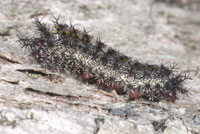 Last week I was in the southern part of Montgomery County and saw an unusually large number of wandering buck moth caterpillars. For those that are not familiar with this insect, it is one of our giant silkworm moths and the caterpillar stage is our largest of the stinging caterpillars in the state. The caterpillar is armed with numerous branched, poison filled spines that will penetrate into one's skin and break off if touched. These stings are very painful and there is often considerable localized swelling.
Last week I was in the southern part of Montgomery County and saw an unusually large number of wandering buck moth caterpillars. For those that are not familiar with this insect, it is one of our giant silkworm moths and the caterpillar stage is our largest of the stinging caterpillars in the state. The caterpillar is armed with numerous branched, poison filled spines that will penetrate into one's skin and break off if touched. These stings are very painful and there is often considerable localized swelling.
The two-inch long buck moth caterpillar is brown to purplish-black with numerous yellow spots. The body is protected with branched reddish spines that may have red or black tips. These can be quite common on oak or willow from spring to mid-summer, however, when wandering as they are now, they can be found almost anywhere, even on other plant types. One might reason that such a well defended caterpillar might have warning coloration (contrasting red or yellow and black), but this one is easily concealed in when resting on the trunk of a tree. They can be common in parks, wooded areas, or other areas with oak trees. Fortunately, there is only a single generation per year.
Caterpillar stages of moths often have spines and barbed hooks. Generally, these are for show and are quite harmless. But there are a few stinging caterpillars of various shapes, sizes and colors. Stinging caterpillars possess hollow quill-like hairs, connected to poison sacs, that are used as defensive weapons. When these hairs are touched they break through the skin releasing the poison. Reactions can range from a mild itching to the more severe pain, dermatitis, and even intestinal disturbances.
There is another giant silkworm moth that also has these stinging hairs, the Io moth caterpillar. This is also a large leaf feeding caterpillar with numerous spines over the body similar to the buck moth. This insect in now flying and laying eggs in similar wooded areas. The larvae are active through mid to late summer. The caterpillar is distinctive and easy to spot relative to the buck moth caterpillar. The Io moth caterpillar is overall light green to yellow, but along each side there is a narrow reddish line bordered below by a white line. Grown caterpillars are two inches long and covered with branched, black-pointed green spines. They feed on a variety of plants including corn, roses, willow, linden, elm, oak, locust, apple, beech, ash, currant, and clover.


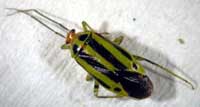 Four lined plant bugs are sap feeding insects that leave distinctive spots where they fed on plant foliage. These insects with a trendy impact color feed on many woody ornamentals but are especially problematic on herbs, mint, and flowering annuals. Plant tissue around the insertion point of their mouthparts turns light green and eventually blackens. A distinct spot usually can be seen in the center of the lesion. Feeding damage by winged adults often is scattered and not noticeable but the wingless nymphs are limited to crawling so they feed over a limited area leaving concentrated areas of spotting.
Four lined plant bugs are sap feeding insects that leave distinctive spots where they fed on plant foliage. These insects with a trendy impact color feed on many woody ornamentals but are especially problematic on herbs, mint, and flowering annuals. Plant tissue around the insertion point of their mouthparts turns light green and eventually blackens. A distinct spot usually can be seen in the center of the lesion. Feeding damage by winged adults often is scattered and not noticeable but the wingless nymphs are limited to crawling so they feed over a limited area leaving concentrated areas of spotting.
There is one generation each year with damage most apparent in mid-summer. Insecticidal soap can provide acceptable control of the immature stages but are less effective against the mobile adults because the insects must be hit with spray droplets to be killed. Physical protection of herbs and mints with a cheesecloth covering may be an acceptable alternative for small plantings.
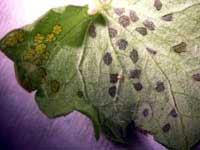
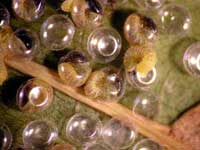 Many of the tree-feeding caterpillars are becoming active now (egg hatch at left). It is easy to overlook the early feeding damage by small caterpillars and be caught off guard when they really begin to feed late in their developmental cycle - the damage appears overnight.
Many of the tree-feeding caterpillars are becoming active now (egg hatch at left). It is easy to overlook the early feeding damage by small caterpillars and be caught off guard when they really begin to feed late in their developmental cycle - the damage appears overnight.
Light to moderate feeding damage generally does not pose a great threat to healthy established landscape trees. Tolerating a degree of insect damage allows natural enemies (beneficial insects or diseases) to provide natural, sustainable pest control. Trees can better cope with these challenges if they are kept healthy thru watering, fertility, and pruning.
Pest outbreaks do occur and past years problems are pretty good predictors of repeated troubles. Regular inspection of foliage of early signs of pest problems can minimize surprises and allow application of specific control measures if needed. Bt-based insecticides provide a selective means of achieving caterpillar control but the products are most effective against smaller larvae so early detection is the key to success. Previous problems with the orange striped oakworm caused the homeowner to watch trees carefully. This resulted in detecting the egg mass in the picture above and a chance to limit the severe defoliation of previous years.


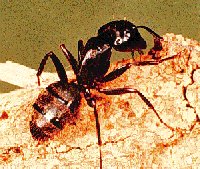 "I'm seeing big, black ants in my house, a few here and there. I spray the ones I see, but they keep coming back. What kind of ants are these and how do I get rid of them?" These are the questions typically asked by clients with carpenter ants. Callers may also complain about a swarm of winged carpenter ants emerging inside their homes - a sure sign that the ants are nesting within the structure.
"I'm seeing big, black ants in my house, a few here and there. I spray the ones I see, but they keep coming back. What kind of ants are these and how do I get rid of them?" These are the questions typically asked by clients with carpenter ants. Callers may also complain about a swarm of winged carpenter ants emerging inside their homes - a sure sign that the ants are nesting within the structure.
Description and Habits
Carpenter ants vary in size and color, but are usually rather large (1/4-1/2") and blackish. Not every large black ant encountered around homes is a carpenter ant, however (see footnote* below). Besides being a nuisance, carpenter ants may damage wood while hollowing it out for nesting. The galleries have a smooth, sandpapered appearance and contain no mud, which distinguishes them from wood damaged by termites. Shredded fragments of wood similar to coarse sawdust are ejected from the galleries, along with dead ants and bits of insects that the carpenter ants have eaten. When such accumulations are found, it's a good indication that a nest is nearby. Often, however, the excavated sawdust remains hidden behind a wall or in some other concealed area.
Carpenter ants nest in moist or dry locations, but prefer those that are moist. Consequently, nests often occur in wood dampened by water leaks, such as around sinks, bathtubs, shower stalls, poorly sealed window and door frames, leaking roofs, and within damp crawlspaces. When considering likely nesting sites, it's also important to remember that carpenter ants nest in areas other than wood. Nests commonly occur in moist, hollow spaces, like the wall behind a dishwasher, beneath insulation in the crawlspace, garage, basement or attic, or in a hollow porch column. False ceilings, hollow-core doors, curtain rods, or even an old suitcase may serve as nesting sites for carpenter ants.
Nests can be located indoors and/or outdoors. Ants spotted indoors may actually be nesting outdoors in a tree stump or landscape timber, and foraging indoors in search of food. Noticing five or more carpenter ants per day in an area of the home where there is no food, such as a bathroom or bedroom, usually indicates an indoor nest. Swarms of winged carpenter ants emerging indoors are another sign of an indoor nest, as is the sighting of ants indoors on cool or rainy days.
The potential for damage exists only when ants are nesting inside the structure. In Kentucky, damage produced by carpenter ants is often insignificant and seldom as extensive as that associated with termites. Nonetheless, over extended periods, large colonies can weaken studs, joists and other structural timbers.
Control Tips
The traditional way to control carpenter ants has been to find and treat the nest(s) directly with an insecticide dust or spray. This is easier said than done. Carpenter ants seldom travel in clearly defined ant "trails" as do many other ants. When attempting to locate a nest, focus your efforts on where most of the ants have been seen. Areas dampened by moisture, e.g., around sinks, dishwashers, chimneys, fascia boards, roof edge, and window or door frames are especially attractive to carpenter ants, although dry walls may also serve as nesting sites. The chances of finding ants will be much greater at night since carpenter ants do most of their foraging after dark.
The vicinity of a carpenter nest can often be located by placing small dabs of honey, jelly, or maple syrup in the area(s) where ants have been seen. Cleanup is aided by placing the "bait" onto small squares of wax paper or the back (non-sticky side) of pieces of masking tape. The best time to check the bait spots is at night when the ants are most active. After the ants have fed on the bait, follow them on their journey back to their nest. Be patient -eventually the ants will disappear behind a baseboard, cabinet, or into some other concealed location such as behind a wall, window, doorframe or porch column.
Treat behind walls and other hidden locations where ants are entering by puffing boric acid dust into existing cracks, or drilling small (1/8") holes into suspected nest areas. With a little luck, the insecticide dust will disperse in the hidden void and contact and kill the ants. If you suspect the nest is in a wall, drill and treat at least 3-6 feet on either side of where ants are entering so as to maximize the chances of contacting the nest. As is true for most ants, carpenter ants prefer to travel along wires, pipes and edges. It often pays to inject dust into any openings around plumbing pipes and behind (not inside) the junction boxes of electrical light switches and receptacles. Never apply insecticides directly into junction boxes or spray liquids around electrical outlets. Turn off the main circuit breaker as an additional safety precaution.
Professional pest control firms have dusters specifically designed for this type of treatment. Homeowners wishing to perform treatment themselves can purchase boric acid in a ready-to-use, squeeze-type bottles. Don't expect to see results overnight; a week or more may be needed to eliminate the entire nest which may contain thousands of ants.
As noted earlier, carpenter ants seen in the home may actually be nesting outdoors and foraging indoors for food and water. Consequently, you may end up following the ants out into the yard, possibly to a nest located in a stump, fence, dead tree limb, etc. Once an outdoor nest is discovered, treatment can be performed by spraying or drenching with Sevin or other liquid insecticide. If outdoor nests are suspected, inspect for ants around the foundation and siding at night with a flashlight. Like most ants, carpenter ants prefer to trail along edges and wires. Pay particular attention to the bottom edge of siding, areas around doors, windows, and where utility pipes and wires enter the structure. The sweet bait technique can again be used to trace these ants back to their nest.
Until recently, few baits were effective against carpenter ants. Do-it-yourselfers may want to try either Terro® Ant Killer II with sodium tetraborate (borax), or Combat® Ant Killing Gel (fipronil). An effective bait used by professionals (Maxforce® Carpenter Ant Gel) can often be purchased on the internet. If carpenter ants can be "enticed" to feed on the insecticide-laced baits, there's a decent chance the colony can be eliminated. The approach is especially worth trying if the location of the nest cannot be found, or is inaccessible.
Calling a Professional
Eliminating carpenter ants can be very challenging and clients may want to call a professional. Pest control companies tackle carpenter ants in different ways. Some try to locate the nest(s) and treat them directly. Other firms take a less targeted approach, treating as many potential nesting sites as possible, or spraying around the exterior foundation of buildings. The approach that should not be taken is simply to spray indoors, month after month, where ants were seen. Knowledgeable companies will spend less time spraying and more time inspecting and asking the homeowner where they have seen ants, whether there have been moisture leaks, etc. The homeowner can often assist the professional in locating nests by using the sweet bait technique discussed earlier. Two excellent new carpenter ant products available to professionals are Maxforce® Carpenter Ant Gel (a carpenter ant-specific version of the Combat® bait mentioned earlier), and Termidor® spray applied around the building exterior. Either product usually will control an existing infestation.
Preventing Future Problems


During the past week, the PDDL received samples of magnesium, nitrogen and phosphorus deficiencies in corn; potassium deficiency in soybean; and black shank, soreshin, potassium deficiency, temporary phosphorus deficiency, manganese toxicity and tomato spotted wilt virus on tobacco.
On fruits and vegetables, we diagnosed anthracnose, black rot and cicada injury on grape; cedar-apple rust and frogeye leaf spot on apple; brown rot, scab and plum curculio injury on peach; Rhizoctonia root/stem rot on bean; bacterial stalk rot on sweet corn; bacterial wilt on cantaloupe and cucumber, as well as gummy stem blight on cantaloupe; Pythium root/basal stem rot and bacterial spot on pepper; bacterial spot, early blight, Septoria leaf spot, gray leaf mold, Rhizoctonia stem rot, Fusarium wilt, tomato spotted wilt virus, southern blight, and poor pollination on tomato.
On ornamentals and turf, we have seen bacterial spot on zinnia; Rhizoctonia and Fusarium crown and stem rots on petunia; powdery mildew on phlox; canker/blight on filbert; anthracnose on maple; Rhizosphaera needle cast on spruce; brown patch and Pythium root rot on turfgrass.


June 27-July 4, 2008
UKREC-Princeton, KY
| Black Cutworm
| 5
| True Armyworm
| 31
| Corn Earworm
| 79
| European Corn Borer
| 0
| Southwestern Corn Borer
| 0
| Fall armyworm
| 0
| | |
Lexington, KY
| Black Cutworm
| 31
| True Armyworm
| 693
| Corn Earworm
| 4
| European Corn Borer
| 0
| Southwestern Corn Borer
| 0
| Fall armyworm
| 1
| | |
Graphs of insect trap counts are available on the IPM web site at - http://www.uky.edu/Ag/IPM/ipm.htm. View trap counts for Fulton County, Kentucky at - http://ces.ca.uky.edu/fulton/anr/
NOTE: Trade names are used to simplify the information presented in this newsletter. No endorsement by the Cooperative Extension Service is intended, nor is criticism implied of similar products that are not named.
Lee Townsend
Extension Entomologist